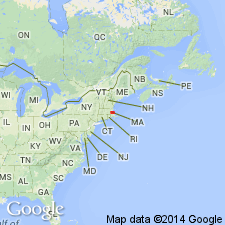
- Usage in publication:
-
- Squantum Member*
- Modifications:
-
- Overview
- AAPG geologic province:
-
- New England province
Summary:
Used as Squantum Member of Roxbury Conglomerate of Proterozoic to earliest Paleozoic age. Included within main body of Roxbury; no members of Roxbury are shown separately on map.
Source: GNU records (USGS DDS-6; Reston GNULEX).

- Usage in publication:
-
- Squantum Member
- Modifications:
-
- Not used
Summary:
Authors state, "...historic stratigraphy and stratigraphic units of the Boston basin are suspect." They suggest that the only formal nomenclature that should be retained is Boston Bay Group, undifferentiated, and perhaps the Weymouth Formation and the Braintree Argillite. Units within the Boston Bay Group--the Cambridge Argillite, and the Brookline, Dorchester, and Squantum (Tillite) Members of the Roxbury Conglomerate--were defined largely on the basis of the percentage of conglomerate, diamictite, argillite, sandstone, siltstone, tuff, and matrix present. Authors believe that recognition of these units in the field is nearly impossible and propose a facies-derived model for the Boston basin. They suggest that the Boston Bay Group was deposited in a submarine fan/slope/apron environment.
Source: GNU records (USGS DDS-6; Reston GNULEX).

- Usage in publication:
-
- Squantum Member*
- Modifications:
-
- Overview
- AAPG geologic province:
-
- New England province
Summary:
Squantum Member of Roxbury Conglomerate is a distinctive diamictite, exposed north of Quincy, MA; however, in Brighton and Hingham, MA, described as a coarse conglomerate. Appears to pinch out in northern part of basin. Age is Proterozoic Z and possibly Early Cambrian. Report includes geologic maps and correlation charts. [Chapters A-J in U.S. Geological Survey Professional Paper 1366 are intended as explanations and (or) revisions to 1:250,000-scale MA State bedrock geologic map of Zen and others (1983).]
Source: GNU records (USGS DDS-6; Reston GNULEX).
For more information, please contact Nancy Stamm, Geologic Names Committee Secretary.
Asterisk (*) indicates published by U.S. Geological Survey authors.
"No current usage" (†) implies that a name has been abandoned or has fallen into disuse. Former usage and, if known, replacement name given in parentheses ( ).
Slash (/) indicates name conflicts with nomenclatural guidelines (CSN, 1933; ACSN, 1961, 1970; NACSN, 1983, 2005, 2021). May be explained within brackets ([ ]).

